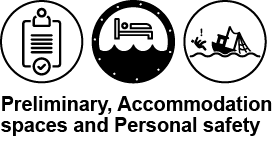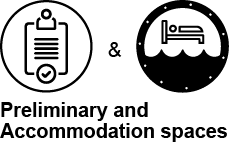For more detail about the following changes please view the draft NSCV C1 with changes highlighted.
Chapter | Proposed Change | Reason for the change |
All | Modernise the format and make the standard easier to read. | Stakeholder feedback that NSCV C1 is overly complex and difficult to understand. |
 | Clarification around the definition of 'special working decks' and 'working decks'. Further mitigation of persons overboard and recovery of persons overboard by improving technology and developing a no-climb zone. | Industry feedback and a high number of enquires seeking clarification on what is a 'special working deck' and a 'working deck'. |
| Toilet and ship sanitation facilities – voyage times and requirement changes. | Industry feedback and a high number of exemptions sorted by industry. |
 | Simplification of the required outcomes to improve readability. | Stakeholder feedback that the NSCV C1 is overly complex and difficult to understand. |
 | Simplify the operating stations, visibility and steering visibility chapter for the industry. | Stakeholder feedback that NSCV C1 is overly complex and difficult to understand. |
 | Old chapter 4 covering COLREGs deleted. NSCV C7C – Navigation Equipment clause 4.4 Consequential amendments, after deleting chapter 4 of NSCV C1 | NSCV C1 COLREG chapter was one page and largely covered by NSCV C7C – Navigation Equipment. This has simplified C1 and reduced duplication. |
 | Minor changes to headroom for larger vessels. | Based on international standards and Maritime Labour Convention (MLC) 2006. |
| Improved requirements around ventilation, both natural and mechanical to improve air quality. | Lessons learnt from the current COVID-19 pandemic and best practice health advice. |
| Noise levels, by pointing to already adopted WHS requirements. | Concurrent legislation exists. |
 | Incorporate National and International standards – Examples include disability access standards, MLC 2006 requirements, stair and ladder requirements. | Industry feedback and best practice to allow alternatives for compliance. |
 | Escape lighting and signage requirements for all class 1, 2 and 3 vessels. | Coronial recommendations linked to several fatalities. |
| Escape routes and design of escapes serving a space. | Stakeholder feedback and internal issues were raised. |
| Modernising the low-capacity escape solutions within the standard | Industry feedback about 1.5m vertical ladders for low-capacity escapes while considering the WHS risk associated. |
 | Minor update to requirements for steps in stairways ased on updates within Australian standards and the National Construction Code. | To align with minor changes embodied within reference standards. |
| Pilot vessel specific safety requirements – colour and continuous safety rails clarified and minor amendments. | Industry feedback around the clarification of highly visible colour and an operational review of the likely loading case of the continuous safety rails. |
| Gangways may not be vessel fitted equipment and could be wharf supplied. Separate the two and develop guidance. | Concurrent legislation exists. |

